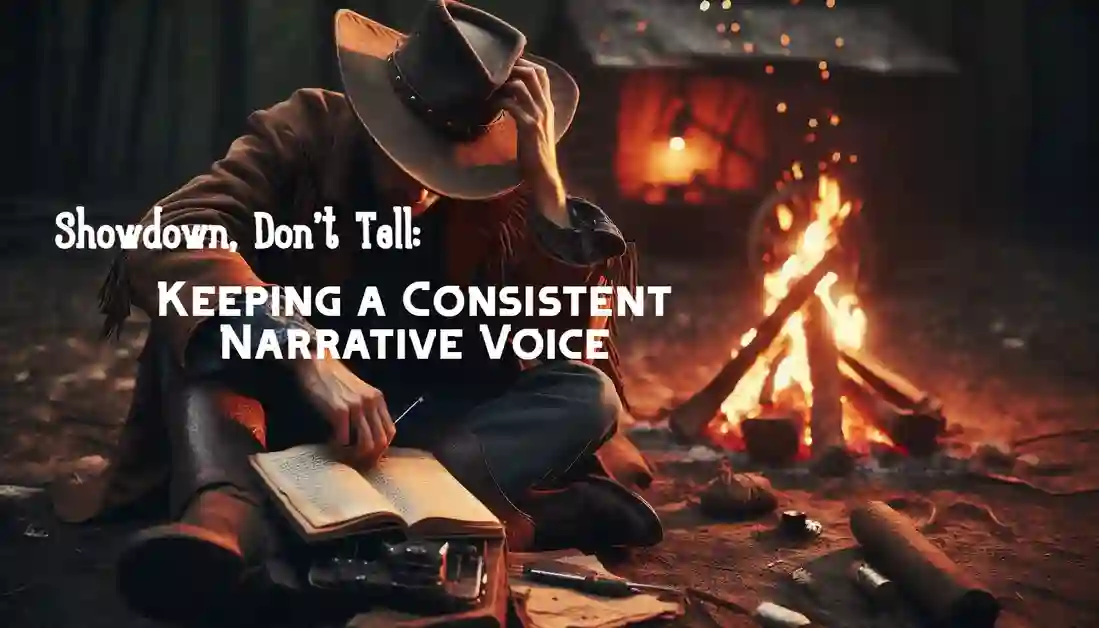Fiction writers have a lot of rules. “Show, don’t tell” sits near the top of the rulebook, right up there with point of view (POV), use of said tags, and eliminating adverbs. But sometimes we follow those rules straight into a literary box canyon. So take off your cowboy hat, sit round the campfire, and let me tell you how I shot myself in the foot trying to follow “show, don’t tell.”
CONTENT WARNING: Description of dead bodies
The Story
I was working on a Weird West story. After crossing a barren desert, my protagonist, Dustcloud LeBlanc, reaches a small farm on the edge of town. Outside the farmhouse, the owner, a woman, was gutting a rabbit to cook. Dustcloud asks permission to water his horse. Nice setup. Now for the zinger.
Dustcloud notices the owner’s husband on the front porch—and he’s dead. He’s been dead a long time. I use fantastic literary language to describe the body’s appearance—the frenzied buzz of flies, the discolored flesh, and the obvious signs that scavengers had visited. And I know, as a writer, that my characters have a sense of smell. So, in my first draft, I described it as follows: Dustcloud smelled the decaying corpse.

No, that wasn’t going to work. How many times had I been told “show, don’t tell”–two or three times in every weekly critique session for maybe the last seven years? After a little mental math, I realized someone had told me “show, don’t tell” over a thousand times. Maybe I should put that advice into practice.
Delete, delete, delete. Think. Aha! I arrived at the perfect way to show this event: The breeze shifted. Dustcloud stifled a cough.
Awesome! I described the action. I gave the reader a visual. It will bring the scene to life in the reader’s mind. I’ve finally mastered “show don’t tell,” one of fiction writing’s most arcane and enigmatic secrets. With my story complete, I submitted it to a publishing market and celebrated with a beer.
The Rejection
After a few agonizing months of repeatedly refreshing my inbox, I received that much-anticipated response. As rejections go, it could’ve been worse. Most are of the form, “Thanks for submitting your story, but it’s not what we’re looking for.”
This rejection was different. It contained snippets taken directly from my story, and the editor described what they liked or didn’t like about each quoted passage. It was like they actually read my submission. Such rejections are rare. In the past, I had joked about printing and framing my rejections. But this was the first time that a framed rejection might be something more than a sad monument to my literary failings.
Before I place my online order for that over-the-top rococo gold frame, I read and re-read every paragraph, trying to sop up wisdom like a Vulcan in a mind meld. This rejection email held the key to becoming a successful writer, I was sure of it. One passage, in particular, pulled me in like a black hole.
The narrative often felt to me more distant or external from Dustcloud than I needed in order to feel like I was at his side rather than watching him from arm’s length, like “Dustcloud stifled a cough.”, when the breeze shifted and he presumably smelled the body, rather than something that more conveyed what his experience in that moment was like.
So much for my brilliant example of “show don’t tell.”
What had I done wrong? Sometimes the story and writing are fine, but it’s not what the editor was looking for. Was that what happened here? If so, should I just ignore their feedback? I had to re-read the rejection email, eat a pint of ice cream, toss and turn in bed at 4 AM, and clamp a vise to my skull before it dawned on me. In my zealous attempt to “show don’t tell,” I had sacrificed my close narrative POV.
The Narrative POV
In The Six Narrative Perspectives, author R. C. Beckett describes the third-person limited narrator:
The narrator… describes (narrates) what that character can see or otherwise sense.
I thought that was what I had done. Dustcloud was certainly aware he was stifling a cough. Yet, the third-person limited narrative voice is sometimes called third-person close, and indeed this is a more accurate name for the dominant narrative voice in contemporary fiction. Today’s editors want a tight connection with the protagonist, even in third-person.
Think about the last time you stifled a cough. Did you turn to someone and declare, “I stifled a cough”? I doubt it. More than likely, you describe what triggered the cough. That enchilada you were eating was so good that you accidentally inhaled it, or someone’s witty comment almost made you blow Coke Zero out your nose. You described it that way because that was your experience.
Dustcloud’s trigger was the rich stench of a rotting corpse. When I merely implied the smell, I stepped away from Dustcloud’s experience. So did the reader, who was left to watch Dustcloud stifle a cough rather than experience the stench that triggered it. I thought I was being clever, implying the odor and showing it with a stifled cough. Instead, I was changing the narrative voice—and yanking the reader out of the story came part and parcel.
What voice had I switched to? R. C. Beckett has the answer: third-person objective. I had described my protagonist’s cough as if I were a neutral observer.
So is it wrong to say your character stifled a cough? It depends on your POV and narrative voice. If a non-POV character stifles a cough, then describe it as such and get on with your story. But for the POV character in third-person limited, find a description that’s as immediate and hard-hitting as you can conjure.
The Fix
Keeping third-person limited in mind, and remembering my story was a Western, I did away with the stifled cough. Here’s the result: When the breeze shifted, the smell got up in Dustcloud’s nose—the same smell scavengers leave after they had their fill.
That works better. It’s evocative enough to elicit the reader’s experience with the smell of decay, but it keeps the reader firmly in Dustcloud’s head. And it’s got that Western vibe that meshes with the story’s setting and theme.
Writing Into the Sunset
(You didn’t believe you could get through this blog without that pun, did you?)
I thought I had mastered “show, don’t tell.” But in chasing that goal, I left my character behind. It took a humbling rejection—and a smell that would not settle for being implied—to teach me how to describe with a close narrative POV. Show, don’t tell? Definitely. But if you want the reader to feel the saddle creak, let them ride double with your protagonist.

Paul is a prizewinning speculative fiction author, technology blogger, and former punk rock drummer. At age six, he saw 2001: A Space Odyssey on the big screen, which lead him to a collection of Clarke’s short stories and a lifelong insatiable appetite for mind-bending science fiction. His work is published or forthcoming at Uncharted Magazine, Amazing Stories, Creepy Podcast, Sci-Fi Lampoon, and others. Originally from Flint, MI, Paul resides in Colorado, where he tries to avoid reliving his punk rock days.

